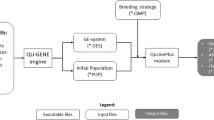Abstract
The major goal for long-term poplar breeding can be formulated as maximizing annual progress in Group Merit Gain at a given annual budget (GMG/Y *). To evaluate different breeding scenarios, a deterministic simulator BREEDING CYCLE ANALYZER covering the most important aspects (gain, cost, time, technique, and gene diversity) of a full breeding cycle was used. The breeding strategies considered was based on pairwise crossing of the selected breeding population and balanced within family selection for the next breeding population. A main scenario and a number of alternative scenarios within these constraints were evaluated using estimates of the best available inputs for poplars. In focus was a comparison between three different testing scenarios for selecting the parents mated to create future breeding generations, thus selecting based on phenotype, clone test or progeny test. For the main scenario, the highestGMG/Y, and the optimal selection age for clone, phenotype and progeny strategies were 0.7480%, 0.6989% and 0.4675%; 7, 6, and 11 years respectively. Clone test was best except when heritability was high, plant price was high or total budget was low; phenotype strategy was the second except for the case of extremely low narrow-sense heritability, for which the progeny strategy was a little more efficient than phenotype strategy.GMG/Y was markedly affected by narrow-sense heritability, additive variance at mature age, rotation age, plant-dependent cost, total budget and the time needed to produce the test plants, while diversity loss and recombination cost had rather weak effect onGMG/Y. Short rotation age and cheap testing cost favoured all three testing strategies. Comparably short rotation age, low plant-dependent cost and high total budget seem to promote early selection for progeny strategy.
Similar content being viewed by others
References
Bisoffi, S. and Gullberg, U. 1996. Poplar breeding and selection strategies [C]. In: Stettler, R.F., Bradshaw, H.D., Jr., Heilman, P.E. and Hinckley, T.M. (eds.), Biology of Populus and its implications for management and conservation. Ottawa, ON: NRC Research Press, National Research Council of Canada, pp. 139–158.
Burdon, R. 1986. Clonal forestry and breeding strategies- a perspective [C]. In: Proc. IUFRO Meeting of Working Parties on Breeding Theory, Progeny Testing, Seed Orchards, Oct. 13–17, Williamsburg, Virginia, N. C. State University-Industry Coop. Tree Imp. Prog., pp. 645–659.
Danell, Ö. 1993. Tree breeding strategy: are we too concerned conservationists but inefficient breeders [C]. In: S. J. Lee (ed.), Progeny testing and breeding strategies. Proceedings of the Nordic group of tree breeding, Oct. 1993, Edinburgh. Forestry Commission. 128, pp. 80–94.
Foster, G.S. Selection and breeding for extreme genotypes [C]. 1992. In: Ahuja, M. R. and Libby, W. J. (eds.), Clonal Forestry I, Genetics and Biotechnology [C]. Springer-Verlag, pp. 50–67.
Häggman, H.M., Aronen, T.S. and Stomp, A.M. 1996. Early flowering Scots pines through tissue culture for accelerating tree breeding [J]. Theor. Appl. Genet.,93: 840–848.
Lambeth, C.C. 1980. Juvenile-mature correlation inPinaceae and implications for early selection [J]. Forest Science,26: 571–580.
Li Huogen, Huang Minren and Wan Mingxiu. 1994. Study on relationship between first-order branch characteristics and growth traits, stem form forPopulus deltoides×Populus euramericana F1 clones [J]. J. Nanjing For. Univ.,18: 7–13. (in Chinese)
Lindgren, D. and Werner, M. 1989. Gain generating efficiency of different Norway spruce seed orchard designs [R]. The Institute for Forest Improvement. Rep.,11: 189–207.
Lindgren, D. and Mullin, T.J. 1997. Balancing gain and relatedness in selection [J]. Silvae Genet.,46: 124–129.
Meuwissen, T.H.E. and Sonesson, A.K. 1998. Maximising the response of selection with a predefined rate of inbreeding: overlapping generations [J]. Journal of Animal Science,76: 2575–2583.
Mullin, T.J. and Park, Y.S. 1995. Stochastic simulator of population management strategies for tree breeding: a new decision-support tool for personal computers [J]. Silvae Genet.,44: 133–141.
Riemenschneider, D.E., Stanton, B.J.,et al. 2001. Poplar breeding strategies. In: Poplar culture in North America [C], Dickmann, D.I., Isebrands, J.G., Eckenwalder, J.E., and Richardson, J. (eds.), Ottawa: NRC Research Press, pp 43–73.
Rosvall, O., Lindgren, D. and Mullin, T.J. 1998. Sustainability robustness and efficiency of a multi-generation breeding strategy based on within family clonal selection [J]. Silvae Genet.,47: 307–321.
Rosvall, O. 1999. Enhancing gain from long-term forest tree breeding while conserving genetic diversity [D]. Ph.D. thesis, Swedish University of Agricultural Sciences, Umeå, Sweden, Sylvestria, p 109.
Russell, J.H. and Loo-Dinkins, J.A. 1993. Distribution of testing effort in cloned genetic tests [J]. Silvae Genet.,42: 98–104.
Shaw, D.V. and Hood, J.V. 1985. Maximizing gain per effort by using clonal replicates in genetic tests [J]. Theor. Appl. Genet.,71: 392–399.
Shelbourne, C.J.A. and Jordaan, J.V. 1992. Genetic gains from different kinds of breeding population and seed or plant production population [J]. South African Forestry Journal,160: 49–65.
Stettler, R.F., Bradshaw, H.D., Heilman, P.E. and Hinckley, T.M. 1996. Biology of Populus and its implications for management and conservation [M]. Ottawa: NRC Research Press.
Wei, R.P. and Lindgren, D. 2001. Optimum breeding generation interval considering build-up of relatedness [J]. Canadian J. For. Res.,31(4): 722–729.
Wei, R.P., 1995: Predicting genetic diversity and optimising selection in breeding programmes [D]. Ph.D. thesis, Swedish University of Agricultural Sciences, Umeå, Sweden.
Wu Rongling, Wang Mingxiu, Huang Minren, Lu Sixing, Xu Rong. 1988. Study of new clones of the aigeiros section—the relationships of tree crown structure with growth [J]. J. Nanjing For. Univ.,2: 1–12. (in Chinese)
Author information
Authors and Affiliations
Corresponding author
Additional information
Foundation item: This study was supported by Kempe Foundation, the China Scholarship Council (CSC) and Jiangsu Hi-tech foundation (BG2003306)
Biography: LI Huo-gen (1966-), male, Ph.D., associate professor of College of Forest Resources and Environments, Nanjing Forestry University, Nanjing 210037, P.R. China.
Responsible editor: Song Funan
Rights and permissions
About this article
Cite this article
Huo-gen, L., Lindgren, D., Danusevicius, D. et al. Theoretical analyses of testing efficiency in long-term breeding of poplar. Journal of Forestry Research 16, 275–280 (2005). https://doi.org/10.1007/BF02858188
Received:
Accepted:
Issue Date:
DOI: https://doi.org/10.1007/BF02858188




